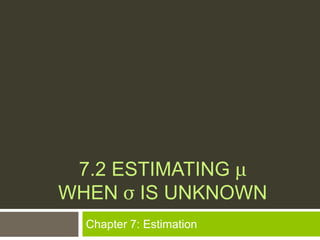
7.2 estimate mu, sigma unknown
- 1. 7.2 ESTIMATING μ WHEN σ IS UNKNOWN Chapter 7: Estimation
- 2. Page 347 Usually, when is unknown, is unknown as well. In such cases, we use the sample standard deviation s to approximate . A Student's t distribution is used to obtain information from samples of populations with unknown standard deviation. A Student’s t distribution depends on sample size.
- 3. Page 348 Student’s t Distribution The variable t is defined as follows: Assume that x has a normal distribution with mean μ. For samples of size n with sample mean and sample standard deviation s, the t variable has a Student’s t distribution with degrees of freedom d.f. = n – 1 Each choice for d.f. gives a different t distribution.
- 4. Properties of a Student’s t Distribution 1. The distribution is symmetric about the mean 0. 2. The distribution depends on the degrees of freedom. 3. The distribution is bell-shaped, but has thicker tails than the standard normal distribution. 4. As the degrees of freedom increase, the t distribution approaches the standard normal distribution. 5. The area under the entire curve is 1. Figure 7-5 A Standard Normal Distribution and Student’s t Distribution with d.f. = 3 and d.f. = 5
- 5. Page 349 Finding Critical Values Table 6 of Appendix II gives various t values for different degrees of freedom d.f. We will use this table to find critical values tc for a c confidence level. In other words, we want to find tc such that an area equal to c under the t distribution for a given number of degrees of freedom falls between –tc and tc in the language of probability, we want to find tc such that P(–tc t tc) = c Figure 7-6 Area Under the t Curve Between –tc and tc
- 6. Finding Critical Values: Using Table 6 1. Find the column with the c heading 2. Compute the degrees of freedom and find the row that contains the d.f. 3. Match the column and row Convention for using Student’s t distribution If the d.f. you need are not in the table, use the closest d.f. in the table that is smaller.
- 7. Page 349 Example 4 – Student’s t Distribution Find the critical value tc for a 0.99 confidence level for a t distribution with sample size n = 5. Student’s t Distribution Critical Values (Excerpt from Table 6, Appendix II) Table 7-3 t0.99 = 4.604
- 8. Page 350 Confidence Interval for μ when σ is Unknown Requirements Let x be a random variable appropriate to your application. Obtain a simple random sample (of size n) of x values from which you compute the sample mean and the sample standard deviation s. If you can assume that x has a normal distribution or is mound- shaped, then any sample size n will work. If you cannot assume this, then use a sample size of n ≥ 30. Confidence Interval for μ when σ is unknown where = sample mean of a simple random sample d.f. = n – 1 = confidence level (0 < c < 1) = critical value
- 9. Not in Textbook! How To Construct a Confidence Interval 1. Check Requirements Simple random sample? Assumption of normality? Sample size? Sample mean? Sample standard deviation s? 2. Compute E 3. Construct the interval using
- 10. Page Example 5 – Confidence 351 Interval
- 11. Solution – Confidence Interval The archaeologist can be 99% confident that the interval from 44.5 cm to 47.8 cm is an interval that contains the population mean for shoulder height of this species of miniature horse.
- 12. Using the Calculator 1. Hit STAT, tab over TESTS, Choose 8:Tinterval 2. Highlight STATS, hit ENTER 3. Enter the requested information 4. Highlight Calculate, Hit Enter Note: The solution will be listed in the format (lower value, upper value)
- 13. Page 353 Summary: Which Distribution Should You Use?
- 14. Assignment Page 354 #1, 4 – 7, 11 – 15 odd